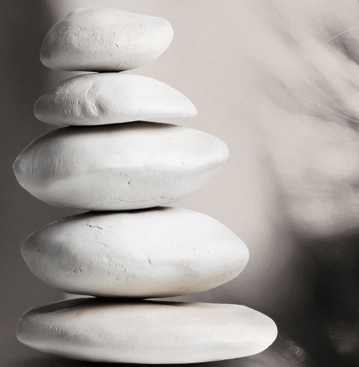
Cultivating inner strength for outer stability
Mindfulness, as we’ve come to practice it now, is based on non-sectarian meditation practices of focused awareness. Just as we train our fingers to play piano, or our muscles to run a marathon, we can also train our selves to have a more wholesome and spacious relationship to our thoughts and feelings.
The benefits are many. Creating a moment of space and dis-identification with the mind, allows us to see the mechanical nature of thought. We become empowered. No longer chained to our habitual reactions, we can choose what we want to respond to and how. We can change our habitual reactions. We can diversify our palette of responses. That space, however small it may seem, can make all the difference.
How Mindfulness Can Help
- We become easy with ourselves and with the way things are.
- Frustration and powerlessness can broaden out to illuminating perspective, context.
- Anger can be dissipated by the powerful solvent of dispassionate understanding.
- Despair and hopelessness can become possibility.
- Boredom can shift into unanticipated curiosity.

Ancient Roots – Contemporary Practice
Mindfulness Meditation has its roots in the awareness practices of early Buddhism, when the young prince Siddhartha, turned renunciate, decided to study the workings of the mind, in a very methodical, scientific fashion. Knowing that he, like all the great realizers he met, also had the power of observation and discernment, so he set out, by sitting and walking in what were then jungles in the contemporary state of Bihar, to figure out how to become free of the shackles of mind and the endless suffering that being overwhelmed by fear, desire, and anger create for us.
Aside from the setting, sound familiar? Wouldn’t it be something to feel we are in control of our lives, rather than our emotions and reactions being in control of us? That’s where mindfulness comes in.
A New Era for Mindfulness Training
We all owe a great debt of gratitude to individuals like Jon Kabat Zinn and others, who began to research the effect of basic mindfulness meditation on overwhelming mental and physical[/column]health issues. Starting at U Mass Medical School in 1979, now 35 years later, MBSR (Mindfulness-Based Stress Reduction) has stimulated our understanding of the relationship between mental health and physical well-being, between meaningful letting go and greater productivity, creativity, and life satisfaction. Meditation has made the cover of Time magazine and into the chambers of Congress. Medical schools like UCLA have extensive mindfulness program as do the armed forces, sports teams, public schools, shelters, and corporations.

What’s Unique about Emergence Education’s Mindfulness Training
All of Emergence Education’s trainings include a section on how cultures develop. Why? We are all products of the time and culture we live in. Personal and individual transformation occurs within a context. We are the way we are in part because of our personal aptitudes and tendencies but our preferences, the conclusions we draw, and what supports our transformation has to do with the cultural climate we live in.
Understanding the characteristics of our culture, and more importantly their deep historical roots (all the way back to early cave-people times), getting the broad brushstrokes of how we’ve evolved to this point, key triggers from early civilization, through modernity, and into these postmodern times, takes the sting out of many of our fears, desires, apprehensions, and insecurities. As we become archeologists of ourselves, we develop a curiosity and spirit of discovery around triggers that previously were fraught with tension. It’s fun and illuminating. And, it’s key to our transformation.
Mindfulness Programs
Corporate Programs
Introduction to Mindfulness
Contextualizing Stress – How Culture Develops
Mindfulness & Cultural Development for Teens
High School Program for Juniors & Seniors
2015 Teacher Training Registration
Community Mindfulness
Tuesdays 7:15 – 8:15 PM Old Swedes Church
Christian & Columbus St., Philadelphia
Individual Mentorship
Intensive Mindfulness Training
Sustained Meditation Practice for Depth & Rejuvenation
3 STEPS

Let Go & Focus The practice of mindfulness allows us to re-habitualize ourselves. Rather than clenching our fists, so wound up we’re like a spring ready to snap, as we learn to let go and breathe, a relaxed focus starts to become part of our experience. That balance point at ease and aware, soft and pliable yet focused and attentive is a powerfully effective posture. From this place we experience more possibility, room for creative thinking, compassion for ourselves, and empathy for others.

Open Your Awareness The practice of mindfulness trains us to open our inner doors of perception. As we come to value and experience fascination with awareness itself, it’s as if we are stretching our faculties of attention and awareness. Just as physically we become more limber and flexible when we stretch our muscles, so our quality of attention becomes more pliant and resilient when we work it in a gentle but deliberate way. Most of us feel blindsided by life far too often. Working our ability to be aware enables us to be present and available so that we can respond to what life sends our way.

Experience Freedom from Thought Mindfulness is a simple practice of observance that enables us to focus in the present tense. Most of us are so bound up and constricted by thought, we feel enslaved to our minds rather than free to use our minds as the miraculous tools they are. We are far too often distracted by fear of the future and anxious about the past. In this state, life passes us by. We feel stressed, confused, alone, dull. Learning to let go of our habitual entanglement with the content of thought, through focus on the breath, sensation, and other immediate and universal human experiences enables us to discover that “we” are other than the content of our thoughts. This has an powerfully liberating effect, enabling us to be both relaxed, at ease, and more in control of what we choose to respond to when it comes to the incessant chatter of our minds.
FREQUENTLY ASKED QUESTIONS
So how does it work?
Mindfulness creates space and interest.
The practice of simple focus and awareness on such fundamental sensations as the breath going in and out, the touch of the sole of our feet with the earth as we walk can separate us from a seemingly relentless bombardment of front line mental attack.
We get space even for a micro-second, and when we do, we prove to ourselves that we can be aware, even if our thoughts spin out of control.
Mindfulness generates interest. Interest in what? In what’s happening. In the immediacy and miraculous nature of awareness or consciousness itself. How does it all work that we can be aware of ourselves being aware? And we become interested and aware of subtle movement, the touch of sunlight, the burst of flavor on our taste buds, the breath.
Try it. Just for a few seconds. Put your attention on the soft sensations of breath passing into your nostrils. And out again. Try it again. What do you notice now?
In those few seconds, no worry, no preoccupation with success or failure, no self judgment or fear. We forget ourselves in the immediacy.
But I have so many responsibilities, I can’t just let go.
Yes, we do. That’s why we want to free our awareness. So when we put our attention to the many decisions that truly are important, we make clear-minded and open-hearted choices.
I’ve never been interested in meditation.
Whether you have trouble concentrated, feel too stressed to add anything else to your schedule, or your boss insisted you try this. Whether you believe you could meditate or you’re convinced you’re “not the type”. The fact that you’ve given it even a little attention so far, is enough curiosity to get going.
Consider it an experiment. One that will be intriguing at the very least. (And will put you at the edge of the curve for one of the recent and highly relevant cultural trends). Enjoy the openness of discovery.
More than that, the practice of mindfulness could potentially change your life—and the lives of the people around you—for the better.
That’s a good enough reason to give it a shot.
SELECTED CLIENT LIST




GETTING STARTED
Client Login
Click here for your password-protected area where you will find a set of instructions and meditations.
Posture
Guided Meditations
Resources
Bibliography, shared by UCSD
Medical Research on Mindfulness: UMass, UCLA, UCSD
